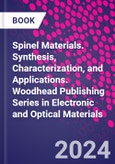Spinel Materials: Synthesis, Characterization, and Applications reviews the key principles, methods, applications, and research directions of spinel materials. Fundamental aspects such as the relationship between their size, metal ion occupancy, and physical behavior are introduced. Then, the synthesis methods to produce these materials and characterization methods used to observe their behaviors are reviewed. The electronic, optical, and magnetic properties of spinel materials make them suitable for wide range of uses, but especially for energy applications. The book reviews the most relevant opportunities and challenges of the use of spinel materials for energy applications.
This resource is suitable for researchers and practitioners working in the subject area of materials science and engineering, and may also be of interest to those working in chemistry or physics disciplines.
This resource is suitable for researchers and practitioners working in the subject area of materials science and engineering, and may also be of interest to those working in chemistry or physics disciplines.
Table of Contents
Section 1: Fundamentals1. An overview of Spinel Materials
2. Magnetic Spinels
3. Non-magnetic Spinels: Onset of Defect Induced magnetism
4. Multiferroic Spinels
5. Spinel Type Superconductors
6. Conduction Mechanism in Spinels
7. Luminescence Behavior of Spinels
Section 2: Synthesis and Characterization
8. Chemical Methods for growth of Spinels
9. Physical Methods for growth of Spinels
10. Cation occupancies in Spinels using X-ray diffractions
11. Neutron Diffraction Study of Spinels
12. Electron Paramagnetic Resonance Study of Spinels Nanostructures
13. NMR studies of Spinels
14. X-ray photoelectron Spectroscopy of Spinels
Section 3: Applications
15. Spinels for batteries applications
16. Spinels for supercapacitors applications
17. Thermoelectric Applications of spinels
18. Photocatalytic Applications of spinels in Environmental Remediation
19. Spinels as low cost electrocatalysts








